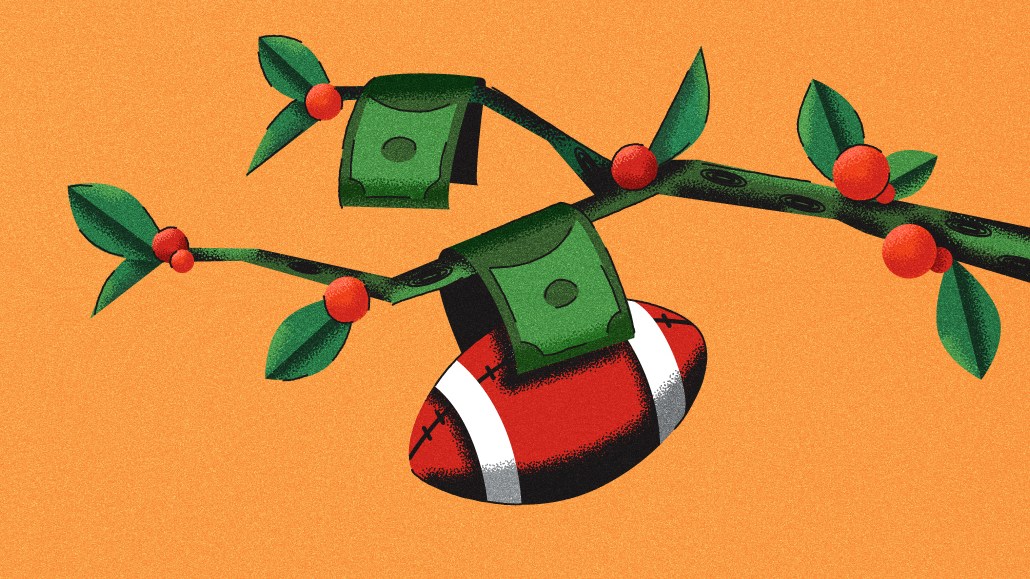Why 2K is investing in sports games with ‘Top Spin 2K25’ and other titles

As video game publishers adjust to a changing market, the lasting popularity of sports games could present a potential lifeline. 2K, the publisher of prominent sports titles such as “NBA 2K” and “WWE 2K,” has a head start in the race for sports properties, and it’s looking to take advantage in 2024.
On Tuesday, 2K published “Top Spin 2K25,” the latest iteration in 2K’s popular series of tennis games. It’s the first “Top Spin” title since 2011’s “Top Spin 4,” and the latest in a succession of sports games to be released by 2K over the past year. According to 2K’s official website, seven of the publisher’s last eight major releases have been sports games, including “WWE 2K24” last month.
Ahead of the release of “Top Spin 2K25,” Digiday spoke to 2K senior director of brand marketing for sports Bryce Yang to learn more about why and how 2K is investing in its sports game portfolio.
This conversation has been edited and condensed for length and clarity.
On the perception of 2K as a sports game publisher

Yang:
To a lot of the more mainstream public, when they think 2K, they definitely think sports. But when we look at some of the biggest franchises in 2K’s history, whether it’s “Borderlands,” “Bioshock,” “Civ[ilization],” “XCOM” — they’re actually non-sports titles. So within the endemic gaming space, I would say that a lot of them actually think of our non-sports titles, but in a more general cultural mainstream, there’s a heavy affiliation with sports. So I think it depends on who you ask.

Digiday:
Sports games are attractive to game publishers because they are able to reach beyond the usual gaming audience to better capture the attention of non-gamers who are fans of traditional sports. “NBA 2K” has practically been a rite of passage for teenagers for years, and games such as “PGA Tour 2K” are often emblazoned with the recognizable faces of star players like Tiger Woods and Justin Thomas.
As gaming in general becomes more mainstream, 2K maintains a strong connection to the core gamer audience as well, thanks to popular titles such as “Bioshock” and “Borderlands.” With a “Borderlands” film adaptation slated for an August 9 release, it’s possible that 2K’s non-sports portfolio could experience a boost similar to the lift enjoyed by the “Fallout” series following its own Amazon Prime television adaptation.
On the decision to bring back ‘Top Spin’ after 13 years

Yang:
When you look at our portfolio, it’s been growing over the last few years, sports and otherwise. Looking at “PGA Tour 2K21,” which was our entry into golf, that franchise has been a huge success. So the powers that be really looked at what else is an opportunity that’s out there. And when you look at tennis itself, tennis is at an inflection point for the sport, right? You have a changing of the guard that’s happening. It’s very exciting to see that, because when that happens, sometimes that comes with the birth of new stars, and new stars are what drive many sports and entertainment businesses.

Digiday:
Yang’s answer to this question reflects 2K’s strong grasp of the traditional sports space and its potential connections to the gaming market. Tennis is indeed at an inflection point among younger viewers, with new stars such as Carlos Alcaraz taking a share of the limelight from older legends like Roger Federer. At the same time, television series such as Netflix’s “Break Point” have introduced a new generation to the personalities of the game.
Tennis’ changing of the guard was reflected in the marketing effort behind “Top Spin 2K25.” The game’s primary cover features veteran players Federer and Serena Williams, but its “deluxe edition” cover features newer stars Iga Swiatek, Frances Tiafoe and Alcaraz, with the latter two promoting the game on their official Instagram pages.
On the potential for in-game advertising in ‘Top Spin 2K25‘

Yang:
Let’s use golf and tennis as an example. Brand representation in the games is authentic, because for so much of golf tournaments and tennis games, we see sponsorship logos everywhere. “The proud partners of the PGA tour,” or the naming rights: “Waste Management Open,” BNP Paribas. It’s just part of the space.
So, when you look at our game, tournaments are named as they are authentically, in billboards, not in an intrusive way. But if you’re playing on the court, you’re going to see some logos, right? And if you didn’t have any of that, you would probably feel quite weird, because that’s what the space is — it’s endemic to the sport.

Digiday:
For all of the reasons stated above, sports games are a natural environment for in-game ads, and Yang’s answer reflects his grasp of this potential revenue stream. While “Top Spin 2K25” won’t roll out with programmatic ads, 2K has intentionally partnered with tennis tournaments such as the Indian Wells Open to include the branding of their sponsors, including the French bank BNP Paribas, in the game.
As gamers increasingly shift their spending habits from premium titles to free-to-play games, the natural advertising opportunities inside sports games could make the genre even more enticing to publishers looking to deepen their revenue streams in in-game ads and in-game purchases.
More in Marketing

Zero-click search is changing how small brands show up online — and spend
To appease the AI powers that be, brands are prioritizing things like blogs, brand content and landing pages.

More creators, less money: Creator economy expansion leaves mid-tier creators behind
As brands get pickier and budgets tighten, mid-tier creators are finding fewer deals in the booming influencer economy.

‘Still not a top tier ad platform’: Advertisers on Linda Yaccarino’s departure as CEO of X
Linda Yaccarino — the CEO who was never really in charge.








